|
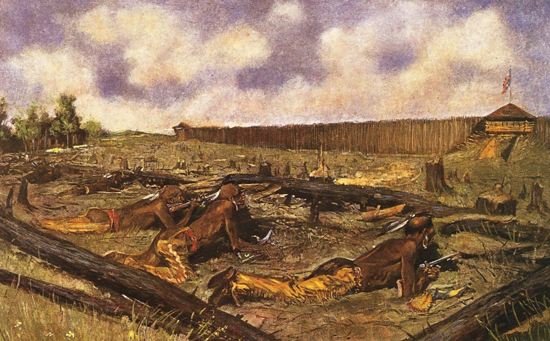
Ottawa vs. British in the
Siege of Fort Detroit, May - October 1763
Ottawa
Native Americans Under Pontiac Besiege Fort
Detroit
But Later They Make Peace
Painting by
Frederic Sackrider Remington / Wiki
Pontiac's Rebellion 1763-1766
Also called
Pontiac Rebellion,
Pontiac Revolt,
Pontiac War,
or, Pontiac's Conspiracy,
all of the above with or without
apostrophe.
 Pontiac, who lived 1720-1769, was a chief of the Ottawa
tribe.
Pontiac, who lived 1720-1769, was a chief of the Ottawa
tribe.
|
|
When Was Pontiac's Rebellion Fought?
From 1763 to 1766.
The main fighting took place in 1763.
Pontiac's
Rebellion begun on April 27, 1763, at an
intertribal war council, when Pontiac and chiefs of
other Indian Nations resolved to wage war.
Pontiac's
Rebellion ended on July 25, 1766, when, at Fort
Ontario, Pontiac and chiefs of other Indian
Nations signed a peace treaty with the British,
who were represented by
 Sir William Johnson.
Sir William Johnson.
Background of Pontiac's Rebellion:
The Ottawa, the French, and the
British
Around
1680, the Ottawa started to trade fur with the white
colonists, who themselves were in competition with each other.
The rivalry between France and Britain resulted in the
 Fourth French and Indian War (1754-1763), which was the North
American extension of the European Fourth French and Indian War (1754-1763), which was the North
American extension of the European
 Seven Years' War (1756-1763). Seven Years' War (1756-1763).
In this war, France fought against
Britain and lost. (Pontiac and many natives fought on the side of the French.) In its concluding
 1763 Treaty of Paris, France ceded Canada to Great Britain.
1763 Treaty of Paris, France ceded Canada to Great Britain.
|
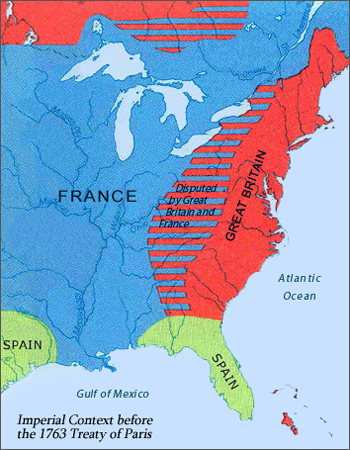
Map of North
America Before the 1763 Treaty of Paris
Imperial Context before the
1763 Treaty of Paris
Library of Congress
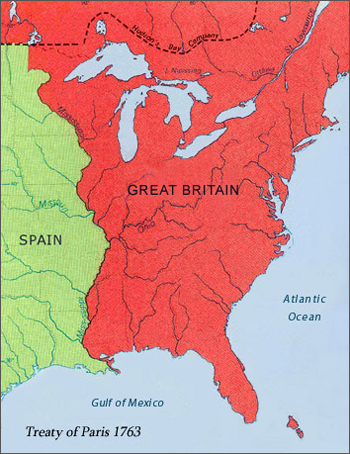
Map of North America After the 1763 Treaty of Paris
Treaty of Paris 1763
Library of Congress
Why Was the Pontiac War Fought?
To eject the
British from the Great Lakes region.
What Caused the Pontiac War?
The
 French
and Indian War
had forced the Native Americans to chose between
the British and the French, which, in turn,
divided their tribes. Pontiac understood that
the unwillingness to unite as one fighting force
would ultimately mean defeat for all tribes. French
and Indian War
had forced the Native Americans to chose between
the British and the French, which, in turn,
divided their tribes. Pontiac understood that
the unwillingness to unite as one fighting force
would ultimately mean defeat for all tribes.
Picking sides
wasn't easy. Some switched sides when Britain
became victorious, others switched sides when
rumors spread that Spain and France joined
forces to drive out the British.
On the whole, the French did get along with the indigenous peoples just
fine. The British did not. How so?
The
French were a bit more easy going than the British. In
general, they mingled with the natives, learned their languages,
adopted their customs, even intermarried. On this
 map of Detroit, it is well
illustrated how the French and the natives lived side by side.
map of Detroit, it is well
illustrated how the French and the natives lived side by side.
The British, on
the other hand, could have a rather snooty attitude and shied away from having closer contact
with the locals. Trade was confined to the forts, and not
carried out in the homes of
the tribal villages. And then, of course, the British
banned
the sale of arms and ammunition, and the sale of rum. They ended the long-standing tradition of gift-giving,
a courtesy the French had practiced. It appears
that, overall, there were a
growing number of incidents in which a British
trader tried to rip off a native. All this alienated a great many Indians.
Here is an often
quoted simplification that nevertheless drives the point
home:
Spanish
civilization crushed the Indian; English
civilization scorned and neglected him;
French civilization embraced and cherished
him.
Francis
Parkman, American historian, 1912
In a nutshell, the causes of Pontiac's Rebellion
were,
1. the urge to
unite lest the white man (whatever country's
origin) takes it all, and
2. the
offensive haughty attitude and intolerable
heavy hands of the new guys in power, the
British. This included both, soldier and
trader.
Who Fought Pontiac's Rebellion?
For 16 months, between 1762 and 1764, Pontiac had rallied his
Confederacy of
a Dozen Tribes, in the struggle against the white colonists.
In effect, this was an insurrection of all the western tribes south
of the Great Lakes and east of the Mississippi River. Apart from organized actions, individual skirmishes
and raids were numerous, causing devastation in Pennsylvania and
Virginia.
Although this confederacy was led by
Pontiac, the vision of an anonymous Delaware
prophet inspired the movement. Either he was anonymous, or his name
was Neolin, depending on your source. In any case, this prophet
preached that the white man, especially when he wears a red coat, should return to wherever he came from,
with the help and convincing of the natives if necessary. And the
Prophet made this aim a religious assignment.
According to vision, this is the wisdom:
This
land where you dwell, I created for you and
no others. Drive out the white man, make war
upon them. Send
them back to the lands I have created for
them. And let them stay therein.
I warn
you that if you
allow the English among you, you are dead.
Maladies, smallpox, and their poison will
destroy you totally. You must pray to me and
do only my will.
:: The Dozen Tribes
The dozen tribes turned out to be more than a dozen. They were the Seneca, the Delaware (Lenni Lenape),
the Mingo, the Shawnee, the
Ottawa, the Ojibwa (Chippewa), the Mississauga, the Potawatomi, the Huron (Wyandot), the Miami, the Wea, the Kickapoo, the Mascouten,
the Illinois (Cahokia, Peoria), Piankashaw, the Menominee, and the
Fox (Mesquakie).
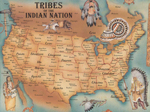
Native American
Tribes
:: The White
Colonists
The French and the British. The French were a remnant of the troops,
and settlers turned habitants, as many of them had been living in
the area for generations by then. The British were the troops and
the new settlers. Britain's monarch at the time was
King George III.
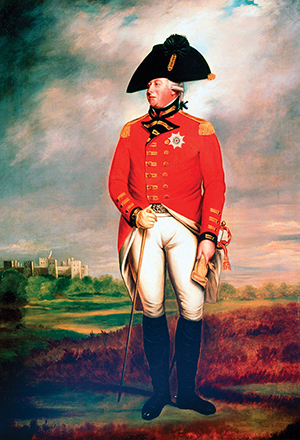
King George III
George ruled as King of Great
Britain and Ireland from 1760–1820.
Ann Ronan Picture
Library/Heritage-Images
Where Was Pontiac's Rebellion Fought?
The Pontiac War targeted the European built
forts along the Great Lakes. Eight of the twelve
attacked forts were captured by Pontiac's Confederation of Tribes.
Here is the map:
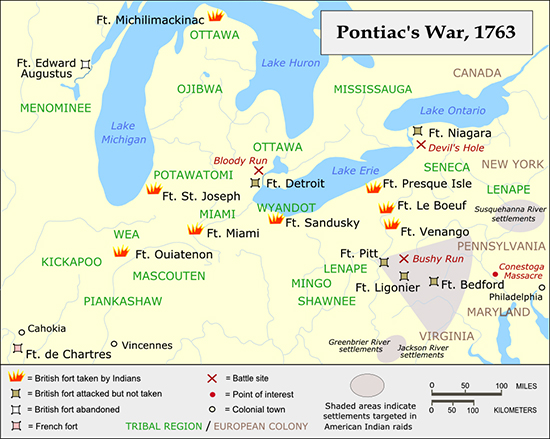
Map Location of Fort Edward Augustus, Fort St.
Joseph, Fort Ouiatenon,
Fort Michilimackinac, Fort Miami, Fort Detroit,
Fort Sandusky, Fort Presque Isle, Fort Le Boeuf,
Fort Venango, Fort Pitt, Fort Ligonier, Fort
Bedford
Click to enlarge
What Was the Outcome of Pontiac's Rebellion?
The uprising
failed to evict the British from
the Great Lakes region, but it did destroy
European built forts and settlements. Although
hundreds of colonists (some sources say up to
2,500) were killed,
Indian losses were heavy as well.
Even if unsuccessful, Pontiac's War was
a most formidable effort of Indian resistance
against the advance of
European colonists. And, in the process, this
uprising forced the colonists to recognize for
the first time, at
least on paper, that Indians had property
rights.
See the
 Royal Proclamation by King
George III
from October 7, 1763.
Royal Proclamation by King
George III
from October 7, 1763.
Key Events Before the Pontiac War
July 24, 1701 -
Fort Pontchartrain du Détroit founded
September 8, 1760
- Vaudreuil surrenders
 New France to
Amherst.
New France to
Amherst.
February 10, 1763 - Treaty
of Paris. New France has
officially become British.
Key Battles and Events of the Pontiac War
April 27, 1763 -
War
Council. Pontiac and other Indian chiefs decide to wage war.
May 7, 1763 -
Pontiac meets with
Gladwin at Fort Detroit, aborts his surprise attack.
May 9, 1763 - The
Siege of Fort Detroit
begins.
May 10, 1763 -
Pontiac takes Campbell and
McDougall hostages.
May 13, 1763 -
Cuyler's British soldiers are ambushed and more than half of them killed.
May 16, 1763 -
Fort Sandusky falls.
May 25, 1763 -
Fort St. Joseph falls.
May 27, 1763 -
Fort Miami falls.
May 28, 1763 - The
Siege of Fort Pitt
begins.
June 1, 1763 -
Fort Ouitenon falls.
June 2, 1763 -
Fort Michilimackinac falls.
Also on June 2,
1763 - Fort Ligonier is attacked
but holds.
June 16, 1763 -
Fort Venango falls.
June 18, 1763 -
Fort Le Boeuf falls.
June 22, 1763 -
Fort Presque Isle falls.
July 4, 1763 -
Captain Donald Campbell is tomahawked.
July 31, 1763 -
Battle of Bloody Run.
Indian victory.
August 5-6, 1763 -
Battle of Bushy Run. British victory.
August 10, 1763 -
The
Siege of Fort Pitt
ends.
September 14, 1763
- Battle of Devil's Hole.
Indian victory.
October 7, 1763 -
 Royal Proclamation by King
George III
Royal Proclamation by King
George III
October 31, 1763 -
The
Siege of
Fort Detroit ends. Pontiac
sues for peace.
July 1765 - George Croghan and Pontiac
sign a preliminary peace treaty.
July 25, 1766 - Pontiac and fellow
chiefs meet at Fort
Ontario and sign a final peace treaty with the British.
Here is the more detailed
 Timeline of Pontiac's Rebellion.
Timeline of Pontiac's Rebellion.
Quote
This is an excerpt from
George Croghan's (Deputy Indian
Agent) letter to his superior Sir
William Johnson, outlining his views
of the policy towards the Indians, best to be
pursued by the English.
In the course of this tour through the
Indian country, I made it my study to
converse in private with Pontiac and several
of the chiefs of the several nations, as
often as opportunity served, in order to
find out their sentiments of the French and
English.
Pontiac is a shrewd, sensible Indian, of few
words, and commands more respect among his
own nation than any Indian I ever saw, could
do among his own tribe.
He and all the principal men of those
nations seem at present to be convinced that
the French had a view of interest in
stirring up, the late difference between his
majesty's subjects and them, and call it a
beaver war, for neither Pontiac, nor any of
the Indians I met with, ever pretended to
deny that the French were at the bottom of
the whole, and constantly supplied them with
every necessary they wanted, as far as in
their power.
And notwithstanding they are at present
convinced that it was for their own
interest, yet it has not changed the
Indians' affection for them.
They have been bred up together like
children in that country, and the French
have always adopted the Indian customs and
manners, treated them civilly, and supplied
their necessities, generally, by which means
they gained the hearts of the Indians, and
commanded their services, and enjoyed the
benefits of a very advantageous fur trade.
They well know if they had not taken these
measures they could not enjoy these
advantages.
[...]
It will require some time, and a very even
conduct in those that are to reside in their
country, before we can expect to rival the
French in their affections. All Indians are
jealous, and from their high notions of
liberty, hate power. Those nations are
jealous and prejudiced against us, so that
the greatest care will be necessary to
convince them of our honest intentions by
our actions.
[...]
They are by no means so sensible a people as
the Six Nations, or other tribes this way;
and the French, for their own advantage,
have learned them a bad custom; for, by all
I could learn, they seldom made them any
general present, but as it were fed them
with necessaries just as they wanted, tribe
by tribe, and never sent them away empty,
which will make it difficult and troublesome
to the gentlemen that are to command in
their country, for some time, to please them
and preserve peace, as they are a rash,
inconsiderate people, and do not look on
themselves as under any obligation to us,
but rather think we are obliged to them for
letting us reside in their country.
This letter has no date, but was probably
written soon after October 21, 1765.
More to Read
:: Robert Navarre
Journal
Here you can read
the
 Journal of Pontiac's
Conspiracy 1763, published by
Clarence Monroe Burton under the Auspices of the
Michigan Society of the Colonial Wars, 1912.
Journal of Pontiac's
Conspiracy 1763, published by
Clarence Monroe Burton under the Auspices of the
Michigan Society of the Colonial Wars, 1912.
Robert
Navarre's Journal ou Dictation d'une
Conspiration (Journal of the Pontiac
Conspiracy) is a handwritten French manuscript,
a first-person account of Pontiac's siege at
Detroit in 1763. The journal describes in great
detail affairs on both sides of the conflict
between May 7 and July 31, 1763, providing an
eyewitness account from within the fort, as well
as intelligence, news, and rumors of Pontiac's
activities. The original French manuscript is
among the collections of the Burton Historical
Collection at the Detroit Public Library.
:: Robert Rogers, John
Bradstreet
This is a
 Diary of the siege of
Detroit in the war with Pontiac :
also a narrative of the principal events of the
siege by Major Robert Rogers; a plan for
conducting Indian affairs, by Colonel Bradstreet
etc., 1860. The authors are Robert Rogers
(1731-1795), John Bradstreet (1714-1774), and
Franklin Benjamin Hough (1822-1885).
Diary of the siege of
Detroit in the war with Pontiac :
also a narrative of the principal events of the
siege by Major Robert Rogers; a plan for
conducting Indian affairs, by Colonel Bradstreet
etc., 1860. The authors are Robert Rogers
(1731-1795), John Bradstreet (1714-1774), and
Franklin Benjamin Hough (1822-1885).
:: Jehy Hay Journal
Here is the
 Jehu Hay Journal,
which is a diary kept by Hay, a lieutenant of
the 60th Regiment (Royal American), while he was
stationed at Detroit from May 1, 1763, to June
6, 1765. In the journal, he wrote a firsthand
account of the Ottawa, Ojibwa, Potawatomi, and
Huron siege of Detroit, led by Pontiac, between
May and October 1763.
Jehu Hay Journal,
which is a diary kept by Hay, a lieutenant of
the 60th Regiment (Royal American), while he was
stationed at Detroit from May 1, 1763, to June
6, 1765. In the journal, he wrote a firsthand
account of the Ottawa, Ojibwa, Potawatomi, and
Huron siege of Detroit, led by Pontiac, between
May and October 1763.
:: Henry
Gladwin
 The Gladwin Manuscripts;
with an introduction and a sketch of the
conspiracy of Pontiac (1897) are written by
Henry Gladwin (1730-1791) and Charles Moore
(1855-1942).
The Gladwin Manuscripts;
with an introduction and a sketch of the
conspiracy of Pontiac (1897) are written by
Henry Gladwin (1730-1791) and Charles Moore
(1855-1942).
:: Francis Parkman
And this is
 The Conspiracy of Pontiac
and the Indian War after the Conquest of Canada
by Francis Parkman (1823-1893) the historian.
The Conspiracy of Pontiac
and the Indian War after the Conquest of Canada
by Francis Parkman (1823-1893) the historian.
More Maps
With regards to
conquest, expansion and colonization, these maps
might be helpful:
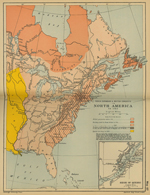
North America to 1763
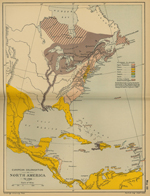
North America Until
1700
Let's wrap it up with another one of Gladwin's brainchildren:
If your
Excellency still intends to punish them for
their barbarities, it may easily be done,
without any expense to the crown, simply by
permitting a free sale of rum, which will
destroy them more effectively than fire and
sword.
Gladwin in a
letter to Amherst
More History
|